Analysis of APN Outdoor's Capital Structure and Financial Health
VerifiedAdded on 2020/04/01
|12
|1593
|35
AI Summary
The assignment is an academic analysis of APN Outdoor's capital structure, assessing the balance between equity and debt in funding operations. It investigates the impact of these financing choices on the company’s Weighted Average Cost of Capital (WACC) and overall financial health. The report reviews financial ratios to gauge performance and compares APN Outdoor's approach with industry peers, particularly noting a shift towards greater reliance on equity. Additionally, it discusses how changes in capital structure could influence market value and shareholder returns. The analysis concludes that while APN Outdoor maintains an adequate capital structure for operational support, strategic adjustments in financing could optimize future financial outcomes.
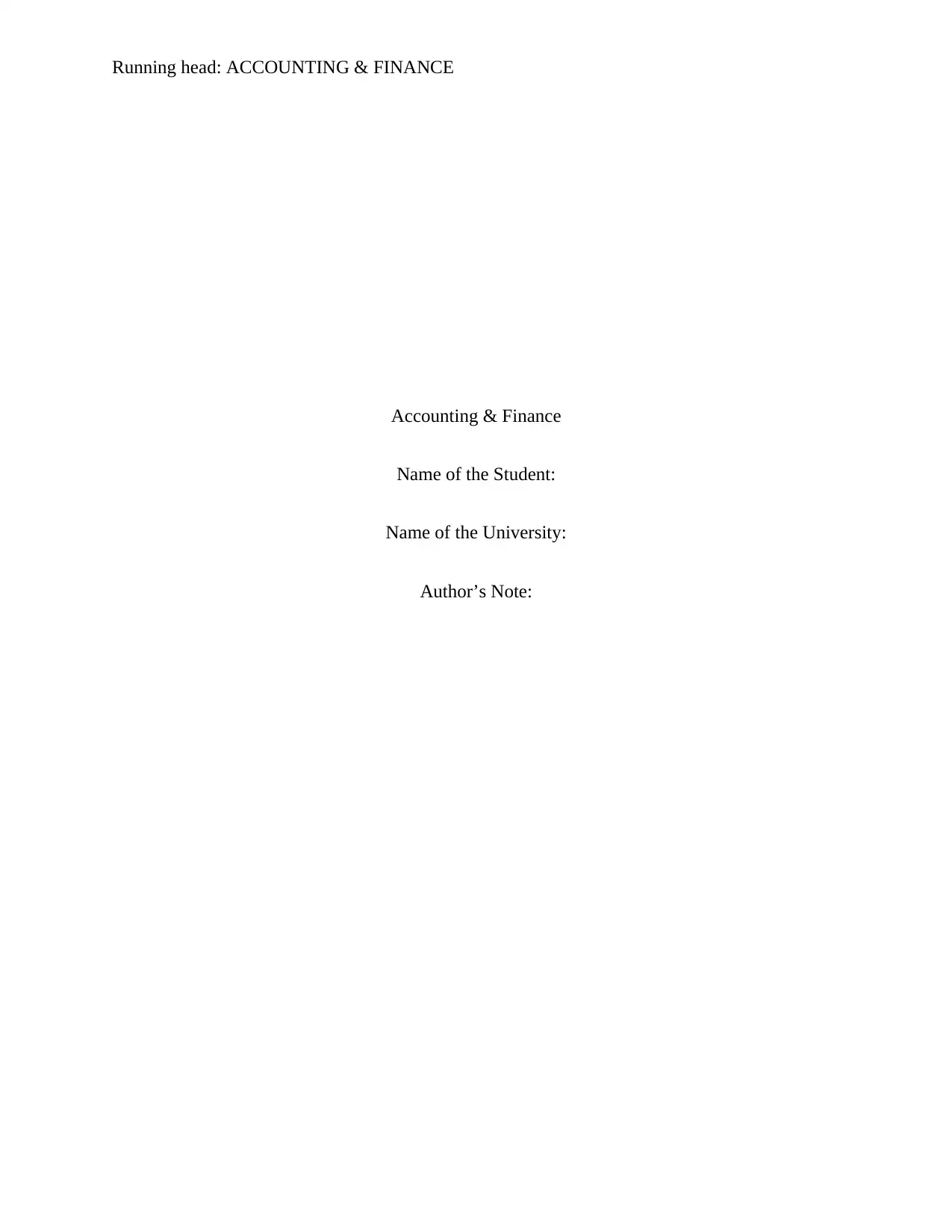
Running head: ACCOUNTING & FINANCE
Accounting & Finance
Name of the Student:
Name of the University:
Author’s Note:
Accounting & Finance
Name of the Student:
Name of the University:
Author’s Note:
Paraphrase This Document
Need a fresh take? Get an instant paraphrase of this document with our AI Paraphraser
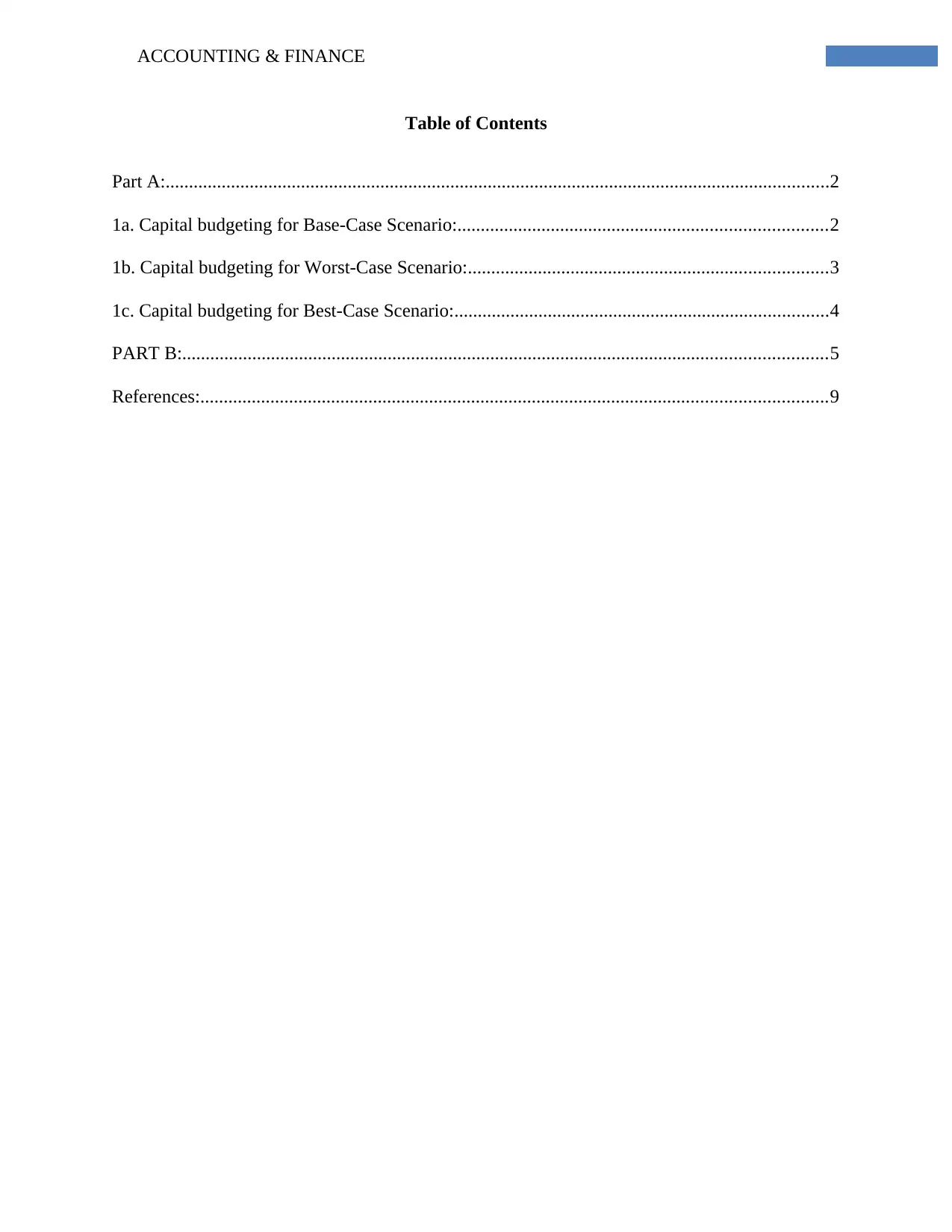
ACCOUNTING & FINANCE
Table of Contents
Part A:..............................................................................................................................................2
1a. Capital budgeting for Base-Case Scenario:...............................................................................2
1b. Capital budgeting for Worst-Case Scenario:.............................................................................3
1c. Capital budgeting for Best-Case Scenario:................................................................................4
PART B:..........................................................................................................................................5
References:......................................................................................................................................9
Table of Contents
Part A:..............................................................................................................................................2
1a. Capital budgeting for Base-Case Scenario:...............................................................................2
1b. Capital budgeting for Worst-Case Scenario:.............................................................................3
1c. Capital budgeting for Best-Case Scenario:................................................................................4
PART B:..........................................................................................................................................5
References:......................................................................................................................................9
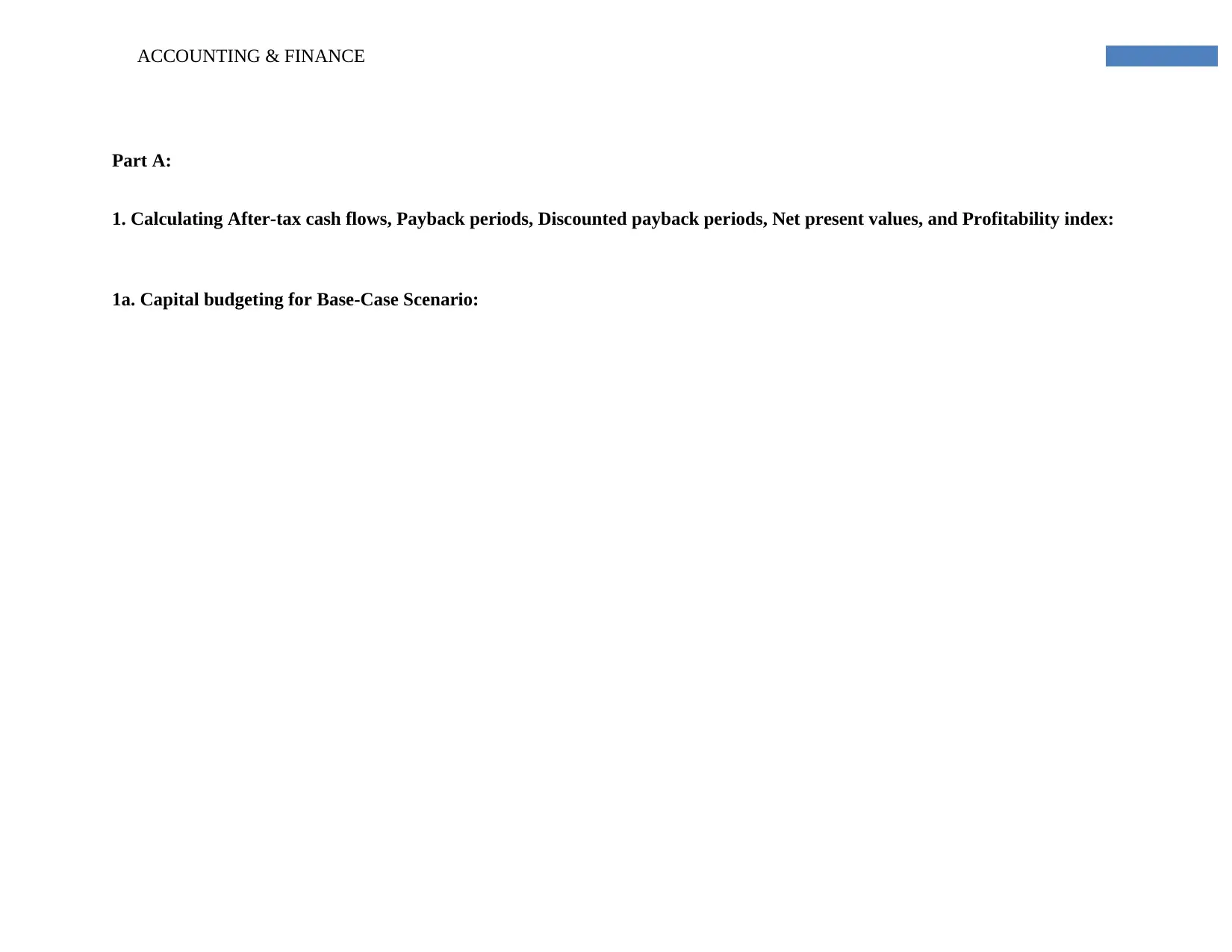
ACCOUNTING & FINANCE
Part A:
1. Calculating After-tax cash flows, Payback periods, Discounted payback periods, Net present values, and Profitability index:
1a. Capital budgeting for Base-Case Scenario:
Part A:
1. Calculating After-tax cash flows, Payback periods, Discounted payback periods, Net present values, and Profitability index:
1a. Capital budgeting for Base-Case Scenario:
⊘ This is a preview!⊘
Do you want full access?
Subscribe today to unlock all pages.

Trusted by 1+ million students worldwide
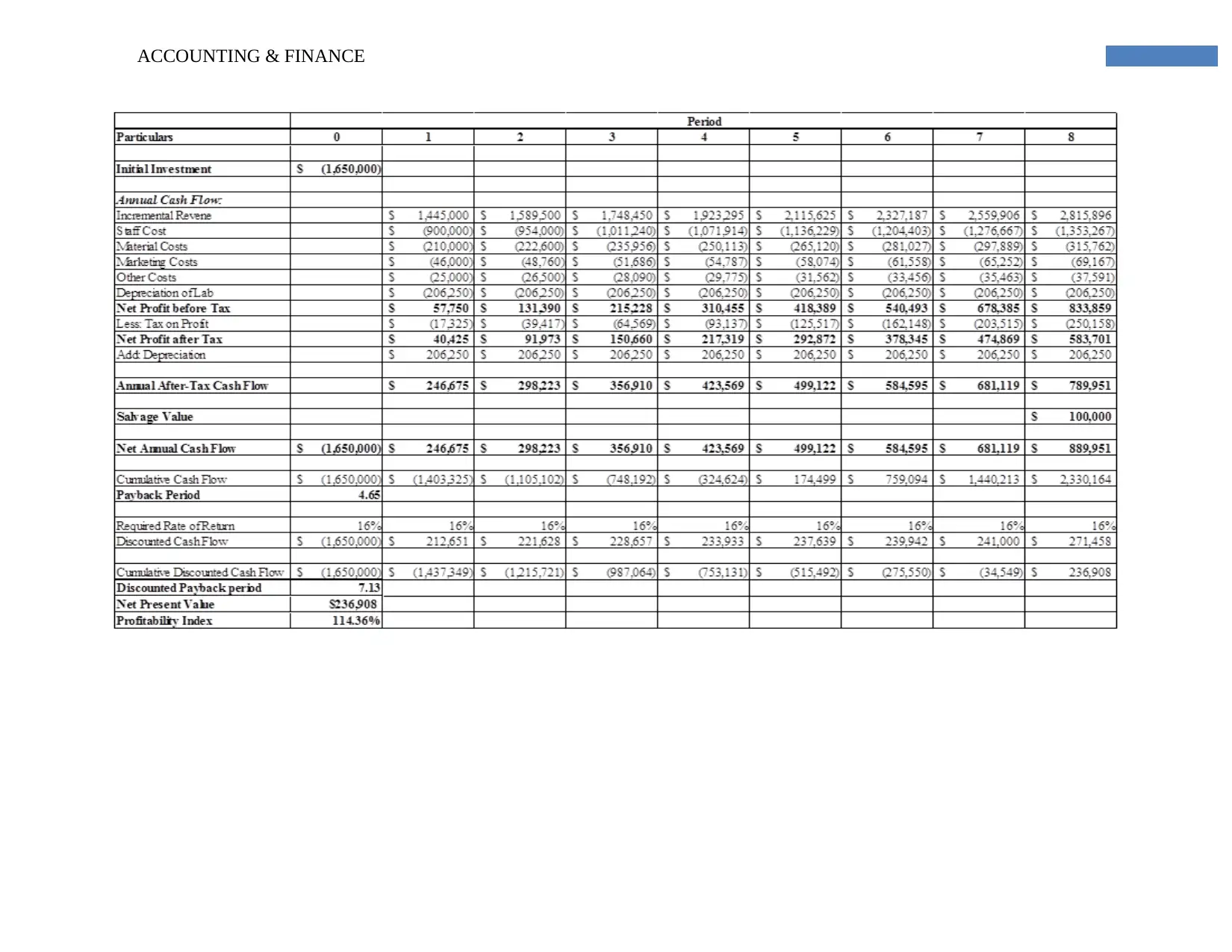
ACCOUNTING & FINANCE
Paraphrase This Document
Need a fresh take? Get an instant paraphrase of this document with our AI Paraphraser
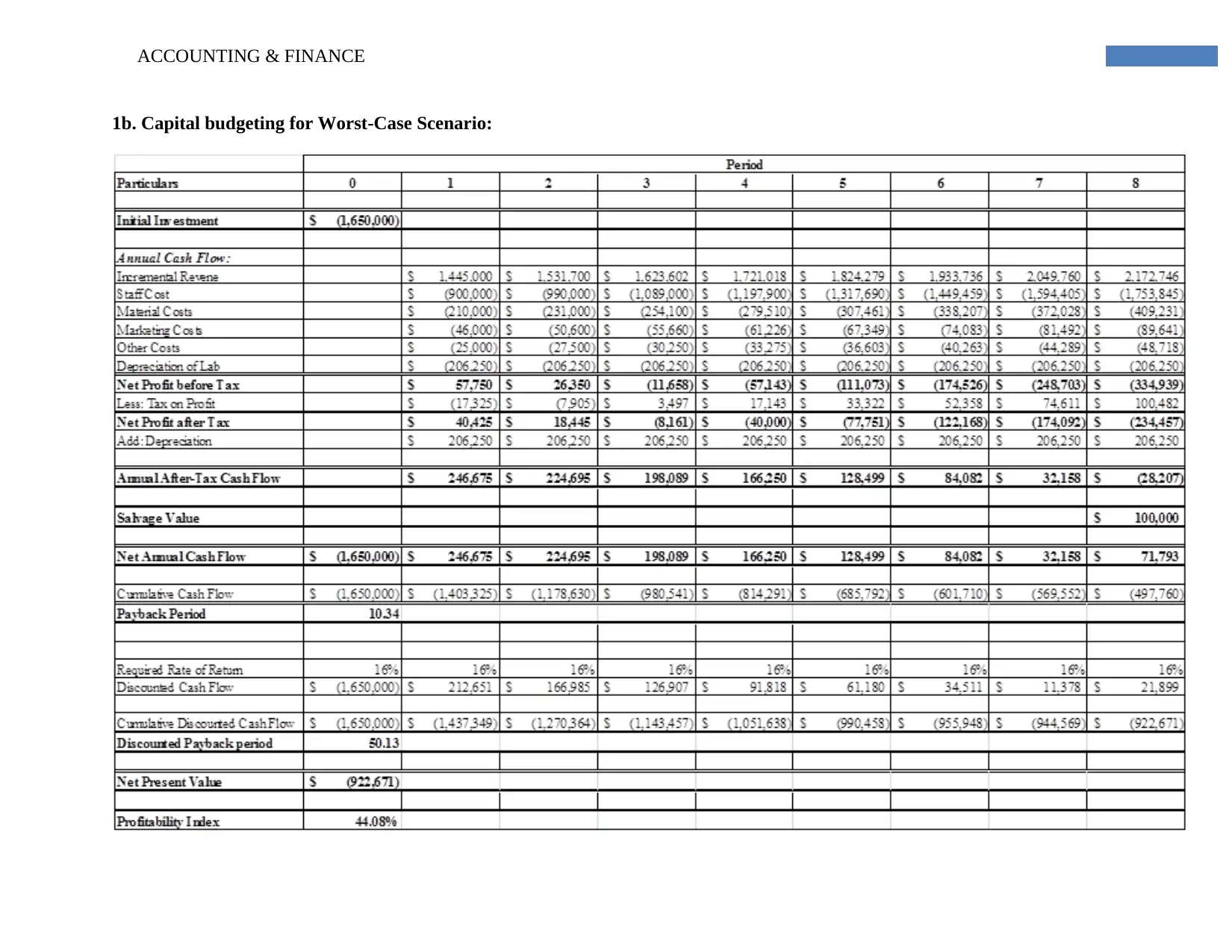
ACCOUNTING & FINANCE
1b. Capital budgeting for Worst-Case Scenario:
1b. Capital budgeting for Worst-Case Scenario:
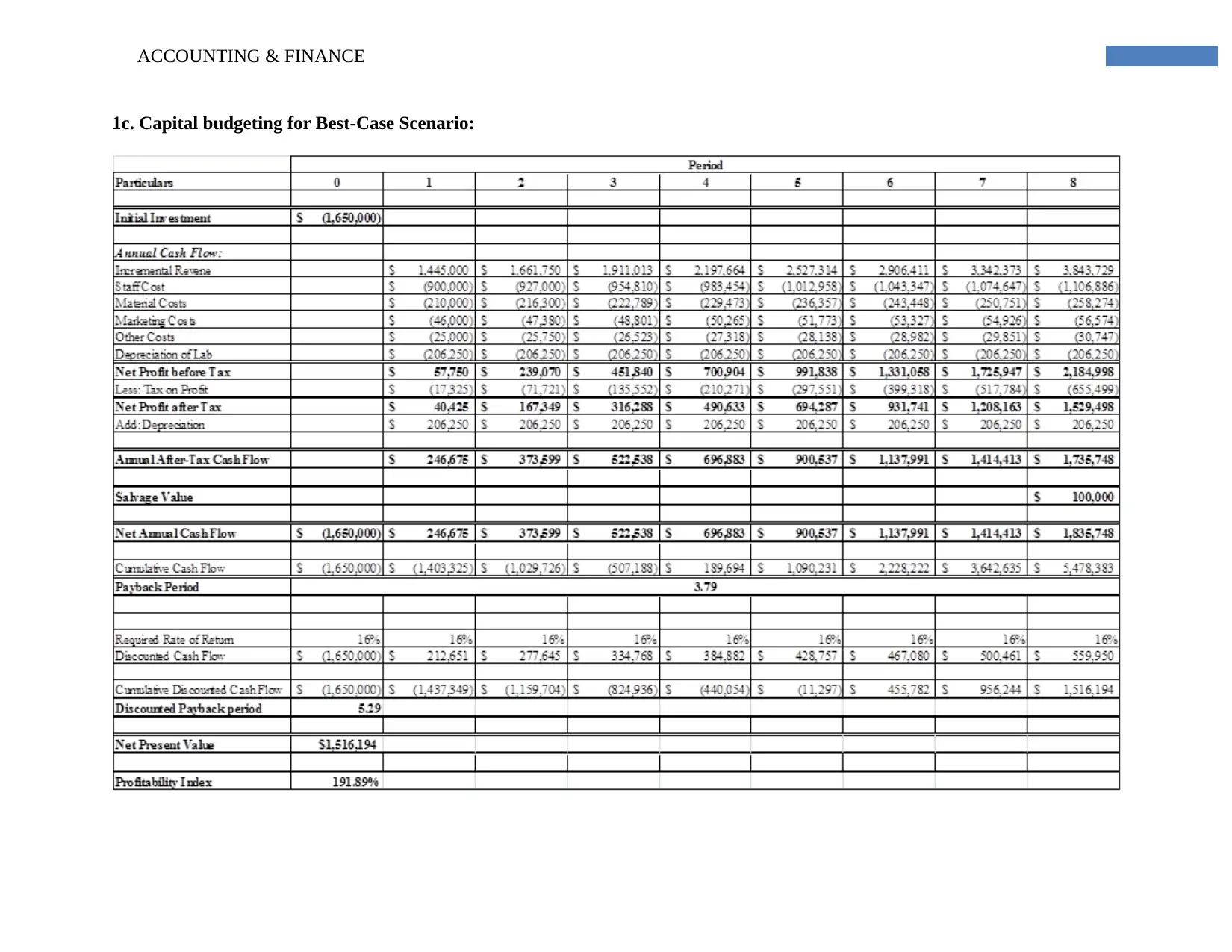
ACCOUNTING & FINANCE
1c. Capital budgeting for Best-Case Scenario:
1c. Capital budgeting for Best-Case Scenario:
⊘ This is a preview!⊘
Do you want full access?
Subscribe today to unlock all pages.

Trusted by 1+ million students worldwide
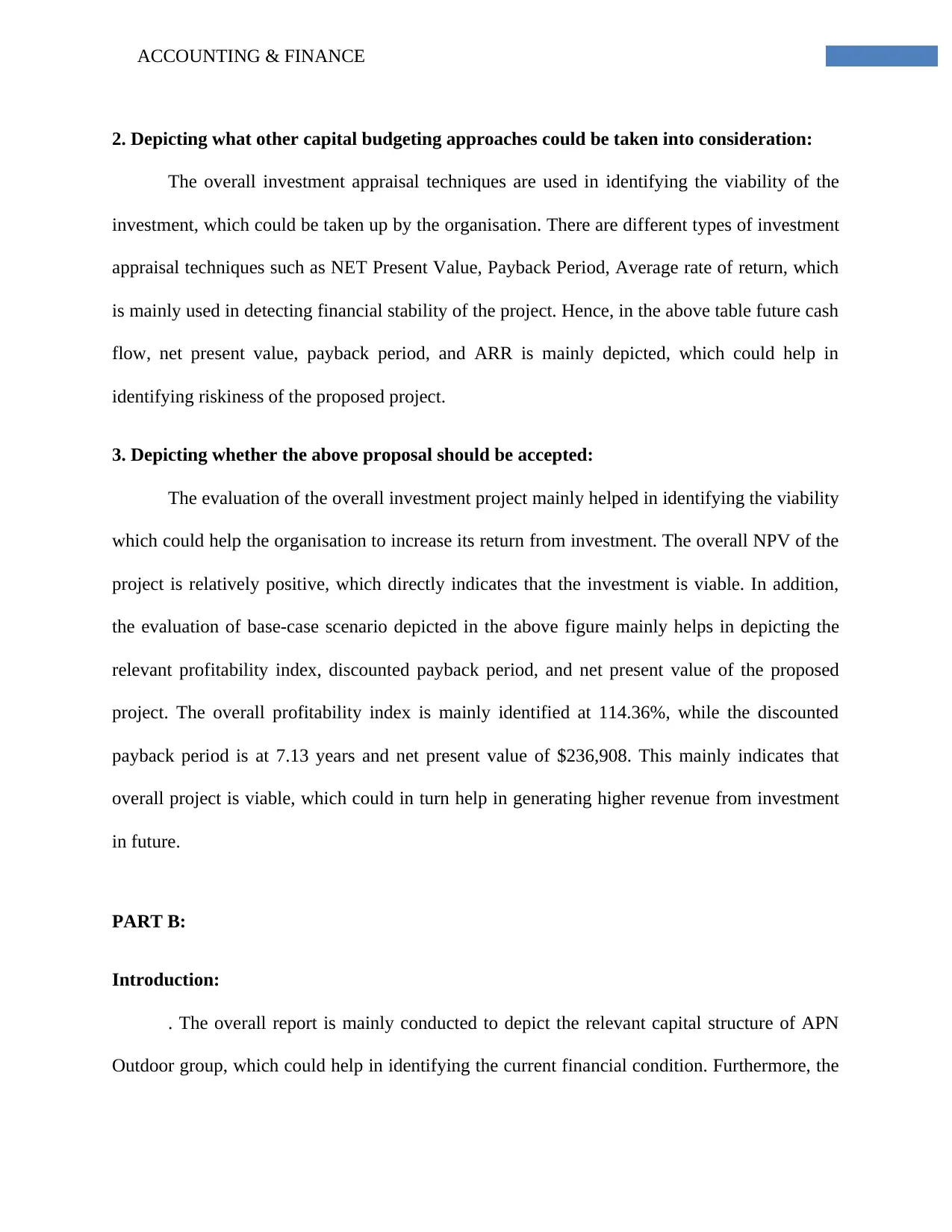
ACCOUNTING & FINANCE
2. Depicting what other capital budgeting approaches could be taken into consideration:
The overall investment appraisal techniques are used in identifying the viability of the
investment, which could be taken up by the organisation. There are different types of investment
appraisal techniques such as NET Present Value, Payback Period, Average rate of return, which
is mainly used in detecting financial stability of the project. Hence, in the above table future cash
flow, net present value, payback period, and ARR is mainly depicted, which could help in
identifying riskiness of the proposed project.
3. Depicting whether the above proposal should be accepted:
The evaluation of the overall investment project mainly helped in identifying the viability
which could help the organisation to increase its return from investment. The overall NPV of the
project is relatively positive, which directly indicates that the investment is viable. In addition,
the evaluation of base-case scenario depicted in the above figure mainly helps in depicting the
relevant profitability index, discounted payback period, and net present value of the proposed
project. The overall profitability index is mainly identified at 114.36%, while the discounted
payback period is at 7.13 years and net present value of $236,908. This mainly indicates that
overall project is viable, which could in turn help in generating higher revenue from investment
in future.
PART B:
Introduction:
. The overall report is mainly conducted to depict the relevant capital structure of APN
Outdoor group, which could help in identifying the current financial condition. Furthermore, the
2. Depicting what other capital budgeting approaches could be taken into consideration:
The overall investment appraisal techniques are used in identifying the viability of the
investment, which could be taken up by the organisation. There are different types of investment
appraisal techniques such as NET Present Value, Payback Period, Average rate of return, which
is mainly used in detecting financial stability of the project. Hence, in the above table future cash
flow, net present value, payback period, and ARR is mainly depicted, which could help in
identifying riskiness of the proposed project.
3. Depicting whether the above proposal should be accepted:
The evaluation of the overall investment project mainly helped in identifying the viability
which could help the organisation to increase its return from investment. The overall NPV of the
project is relatively positive, which directly indicates that the investment is viable. In addition,
the evaluation of base-case scenario depicted in the above figure mainly helps in depicting the
relevant profitability index, discounted payback period, and net present value of the proposed
project. The overall profitability index is mainly identified at 114.36%, while the discounted
payback period is at 7.13 years and net present value of $236,908. This mainly indicates that
overall project is viable, which could in turn help in generating higher revenue from investment
in future.
PART B:
Introduction:
. The overall report is mainly conducted to depict the relevant capital structure of APN
Outdoor group, which could help in identifying the current financial condition. Furthermore, the
Paraphrase This Document
Need a fresh take? Get an instant paraphrase of this document with our AI Paraphraser
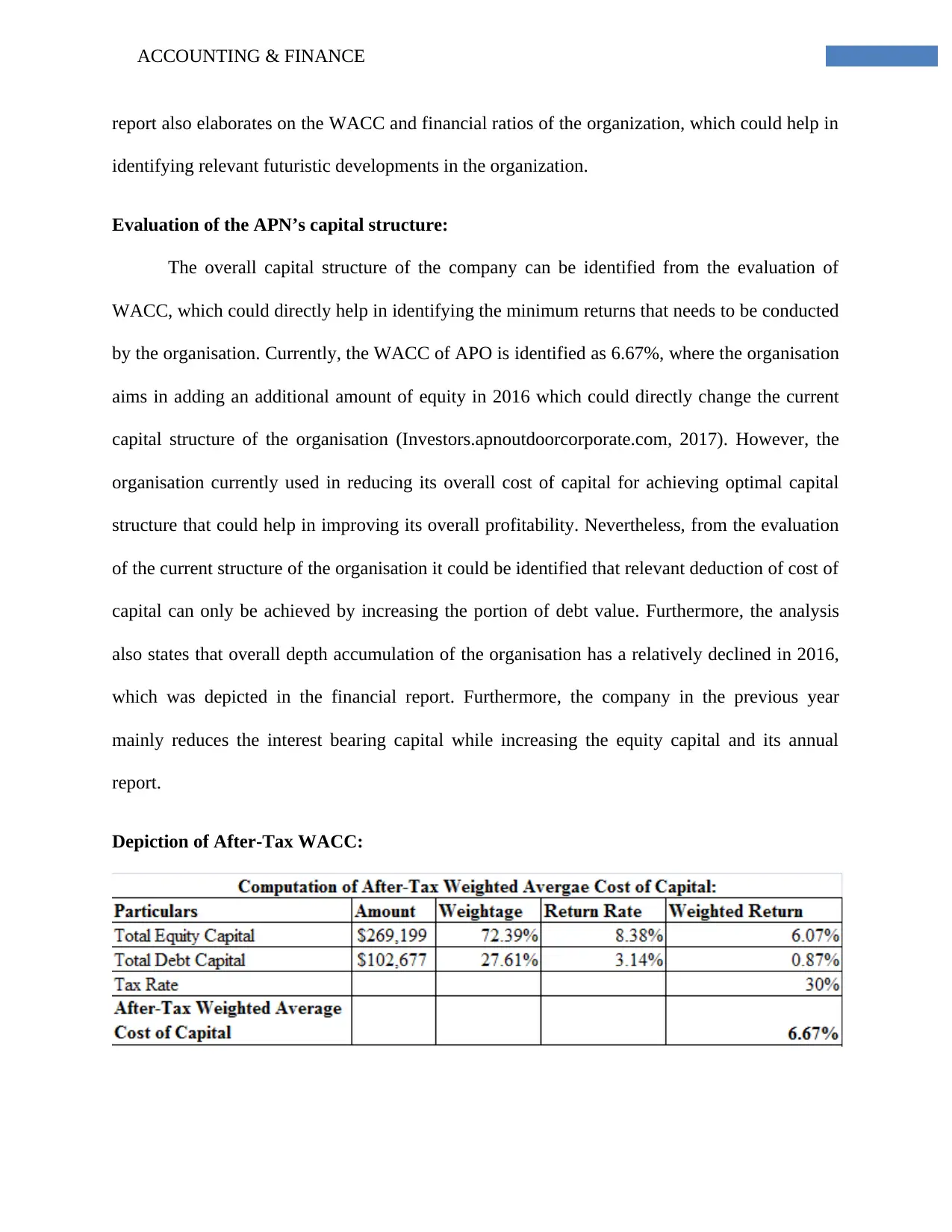
ACCOUNTING & FINANCE
report also elaborates on the WACC and financial ratios of the organization, which could help in
identifying relevant futuristic developments in the organization.
Evaluation of the APN’s capital structure:
The overall capital structure of the company can be identified from the evaluation of
WACC, which could directly help in identifying the minimum returns that needs to be conducted
by the organisation. Currently, the WACC of APO is identified as 6.67%, where the organisation
aims in adding an additional amount of equity in 2016 which could directly change the current
capital structure of the organisation (Investors.apnoutdoorcorporate.com, 2017). However, the
organisation currently used in reducing its overall cost of capital for achieving optimal capital
structure that could help in improving its overall profitability. Nevertheless, from the evaluation
of the current structure of the organisation it could be identified that relevant deduction of cost of
capital can only be achieved by increasing the portion of debt value. Furthermore, the analysis
also states that overall depth accumulation of the organisation has a relatively declined in 2016,
which was depicted in the financial report. Furthermore, the company in the previous year
mainly reduces the interest bearing capital while increasing the equity capital and its annual
report.
Depiction of After-Tax WACC:
report also elaborates on the WACC and financial ratios of the organization, which could help in
identifying relevant futuristic developments in the organization.
Evaluation of the APN’s capital structure:
The overall capital structure of the company can be identified from the evaluation of
WACC, which could directly help in identifying the minimum returns that needs to be conducted
by the organisation. Currently, the WACC of APO is identified as 6.67%, where the organisation
aims in adding an additional amount of equity in 2016 which could directly change the current
capital structure of the organisation (Investors.apnoutdoorcorporate.com, 2017). However, the
organisation currently used in reducing its overall cost of capital for achieving optimal capital
structure that could help in improving its overall profitability. Nevertheless, from the evaluation
of the current structure of the organisation it could be identified that relevant deduction of cost of
capital can only be achieved by increasing the portion of debt value. Furthermore, the analysis
also states that overall depth accumulation of the organisation has a relatively declined in 2016,
which was depicted in the financial report. Furthermore, the company in the previous year
mainly reduces the interest bearing capital while increasing the equity capital and its annual
report.
Depiction of After-Tax WACC:
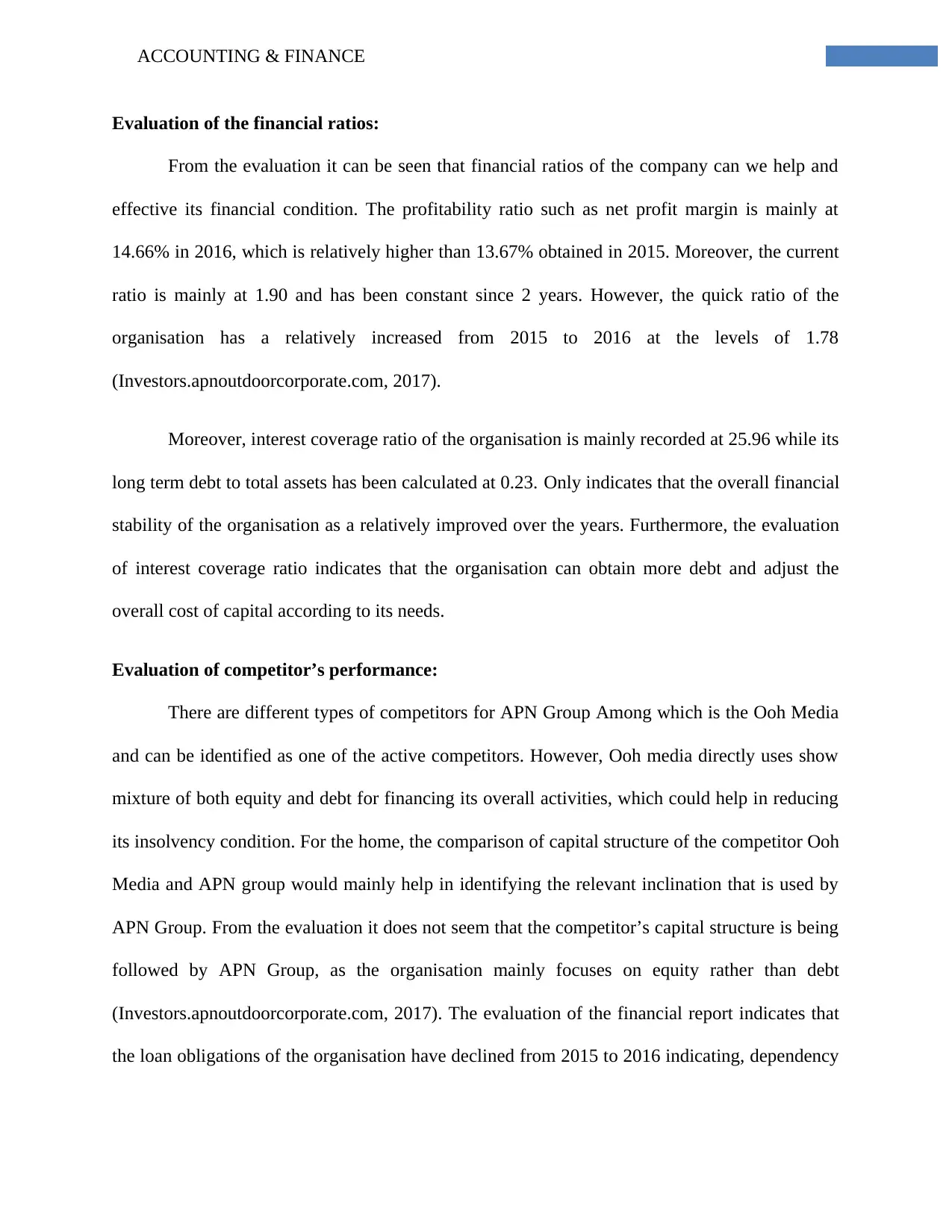
ACCOUNTING & FINANCE
Evaluation of the financial ratios:
From the evaluation it can be seen that financial ratios of the company can we help and
effective its financial condition. The profitability ratio such as net profit margin is mainly at
14.66% in 2016, which is relatively higher than 13.67% obtained in 2015. Moreover, the current
ratio is mainly at 1.90 and has been constant since 2 years. However, the quick ratio of the
organisation has a relatively increased from 2015 to 2016 at the levels of 1.78
(Investors.apnoutdoorcorporate.com, 2017).
Moreover, interest coverage ratio of the organisation is mainly recorded at 25.96 while its
long term debt to total assets has been calculated at 0.23. Only indicates that the overall financial
stability of the organisation as a relatively improved over the years. Furthermore, the evaluation
of interest coverage ratio indicates that the organisation can obtain more debt and adjust the
overall cost of capital according to its needs.
Evaluation of competitor’s performance:
There are different types of competitors for APN Group Among which is the Ooh Media
and can be identified as one of the active competitors. However, Ooh media directly uses show
mixture of both equity and debt for financing its overall activities, which could help in reducing
its insolvency condition. For the home, the comparison of capital structure of the competitor Ooh
Media and APN group would mainly help in identifying the relevant inclination that is used by
APN Group. From the evaluation it does not seem that the competitor’s capital structure is being
followed by APN Group, as the organisation mainly focuses on equity rather than debt
(Investors.apnoutdoorcorporate.com, 2017). The evaluation of the financial report indicates that
the loan obligations of the organisation have declined from 2015 to 2016 indicating, dependency
Evaluation of the financial ratios:
From the evaluation it can be seen that financial ratios of the company can we help and
effective its financial condition. The profitability ratio such as net profit margin is mainly at
14.66% in 2016, which is relatively higher than 13.67% obtained in 2015. Moreover, the current
ratio is mainly at 1.90 and has been constant since 2 years. However, the quick ratio of the
organisation has a relatively increased from 2015 to 2016 at the levels of 1.78
(Investors.apnoutdoorcorporate.com, 2017).
Moreover, interest coverage ratio of the organisation is mainly recorded at 25.96 while its
long term debt to total assets has been calculated at 0.23. Only indicates that the overall financial
stability of the organisation as a relatively improved over the years. Furthermore, the evaluation
of interest coverage ratio indicates that the organisation can obtain more debt and adjust the
overall cost of capital according to its needs.
Evaluation of competitor’s performance:
There are different types of competitors for APN Group Among which is the Ooh Media
and can be identified as one of the active competitors. However, Ooh media directly uses show
mixture of both equity and debt for financing its overall activities, which could help in reducing
its insolvency condition. For the home, the comparison of capital structure of the competitor Ooh
Media and APN group would mainly help in identifying the relevant inclination that is used by
APN Group. From the evaluation it does not seem that the competitor’s capital structure is being
followed by APN Group, as the organisation mainly focuses on equity rather than debt
(Investors.apnoutdoorcorporate.com, 2017). The evaluation of the financial report indicates that
the loan obligations of the organisation have declined from 2015 to 2016 indicating, dependency
⊘ This is a preview!⊘
Do you want full access?
Subscribe today to unlock all pages.

Trusted by 1+ million students worldwide
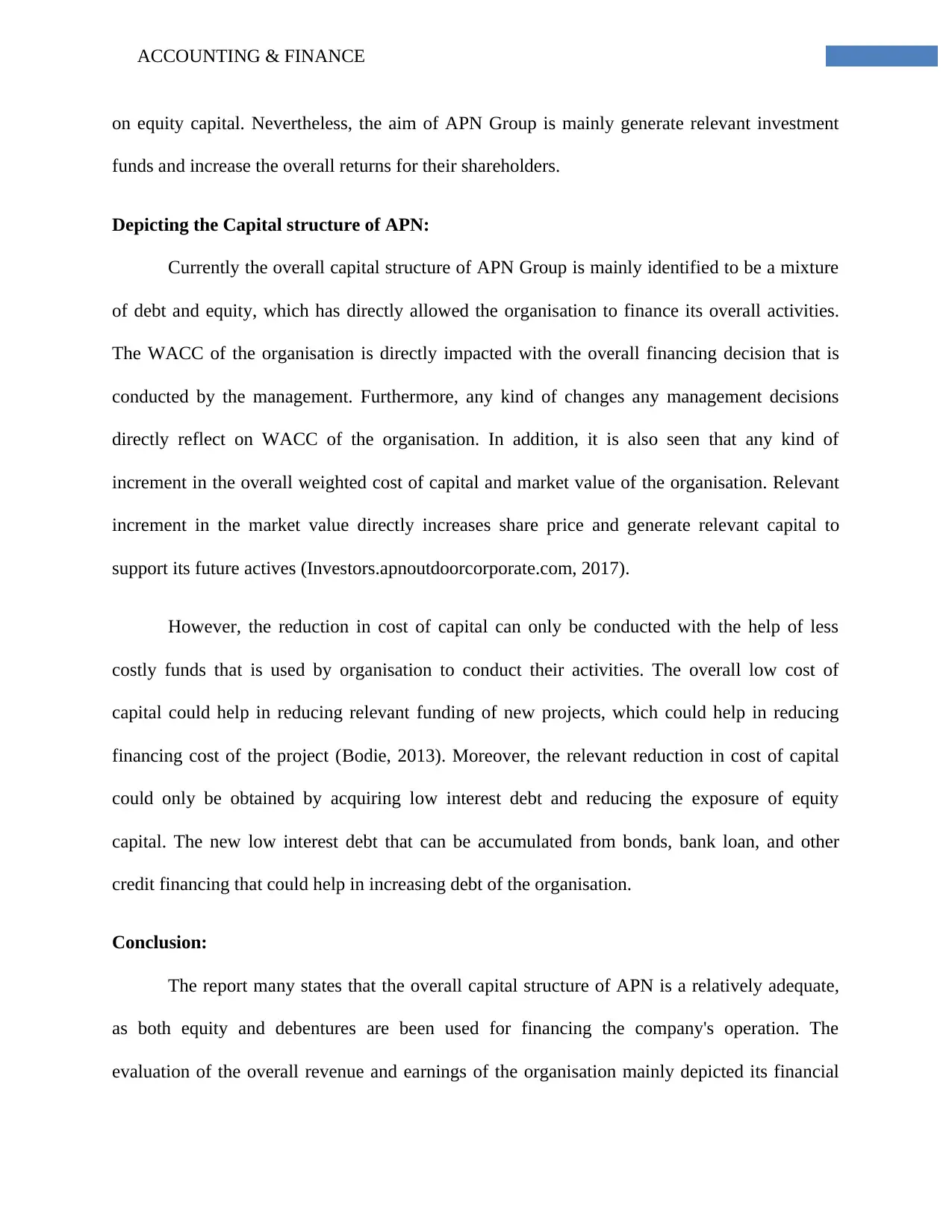
ACCOUNTING & FINANCE
on equity capital. Nevertheless, the aim of APN Group is mainly generate relevant investment
funds and increase the overall returns for their shareholders.
Depicting the Capital structure of APN:
Currently the overall capital structure of APN Group is mainly identified to be a mixture
of debt and equity, which has directly allowed the organisation to finance its overall activities.
The WACC of the organisation is directly impacted with the overall financing decision that is
conducted by the management. Furthermore, any kind of changes any management decisions
directly reflect on WACC of the organisation. In addition, it is also seen that any kind of
increment in the overall weighted cost of capital and market value of the organisation. Relevant
increment in the market value directly increases share price and generate relevant capital to
support its future actives (Investors.apnoutdoorcorporate.com, 2017).
However, the reduction in cost of capital can only be conducted with the help of less
costly funds that is used by organisation to conduct their activities. The overall low cost of
capital could help in reducing relevant funding of new projects, which could help in reducing
financing cost of the project (Bodie, 2013). Moreover, the relevant reduction in cost of capital
could only be obtained by acquiring low interest debt and reducing the exposure of equity
capital. The new low interest debt that can be accumulated from bonds, bank loan, and other
credit financing that could help in increasing debt of the organisation.
Conclusion:
The report many states that the overall capital structure of APN is a relatively adequate,
as both equity and debentures are been used for financing the company's operation. The
evaluation of the overall revenue and earnings of the organisation mainly depicted its financial
on equity capital. Nevertheless, the aim of APN Group is mainly generate relevant investment
funds and increase the overall returns for their shareholders.
Depicting the Capital structure of APN:
Currently the overall capital structure of APN Group is mainly identified to be a mixture
of debt and equity, which has directly allowed the organisation to finance its overall activities.
The WACC of the organisation is directly impacted with the overall financing decision that is
conducted by the management. Furthermore, any kind of changes any management decisions
directly reflect on WACC of the organisation. In addition, it is also seen that any kind of
increment in the overall weighted cost of capital and market value of the organisation. Relevant
increment in the market value directly increases share price and generate relevant capital to
support its future actives (Investors.apnoutdoorcorporate.com, 2017).
However, the reduction in cost of capital can only be conducted with the help of less
costly funds that is used by organisation to conduct their activities. The overall low cost of
capital could help in reducing relevant funding of new projects, which could help in reducing
financing cost of the project (Bodie, 2013). Moreover, the relevant reduction in cost of capital
could only be obtained by acquiring low interest debt and reducing the exposure of equity
capital. The new low interest debt that can be accumulated from bonds, bank loan, and other
credit financing that could help in increasing debt of the organisation.
Conclusion:
The report many states that the overall capital structure of APN is a relatively adequate,
as both equity and debentures are been used for financing the company's operation. The
evaluation of the overall revenue and earnings of the organisation mainly depicted its financial
Paraphrase This Document
Need a fresh take? Get an instant paraphrase of this document with our AI Paraphraser
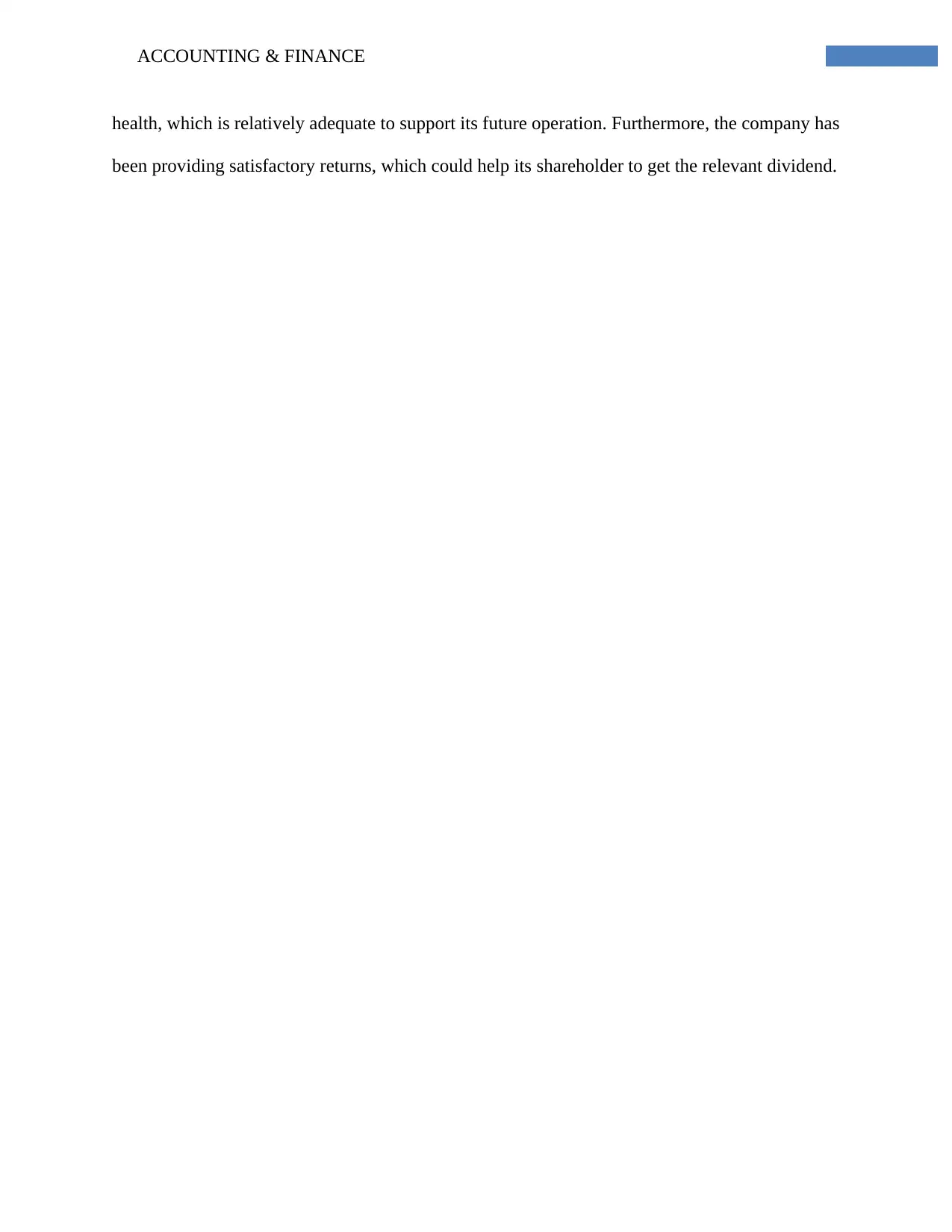
ACCOUNTING & FINANCE
health, which is relatively adequate to support its future operation. Furthermore, the company has
been providing satisfactory returns, which could help its shareholder to get the relevant dividend.
health, which is relatively adequate to support its future operation. Furthermore, the company has
been providing satisfactory returns, which could help its shareholder to get the relevant dividend.
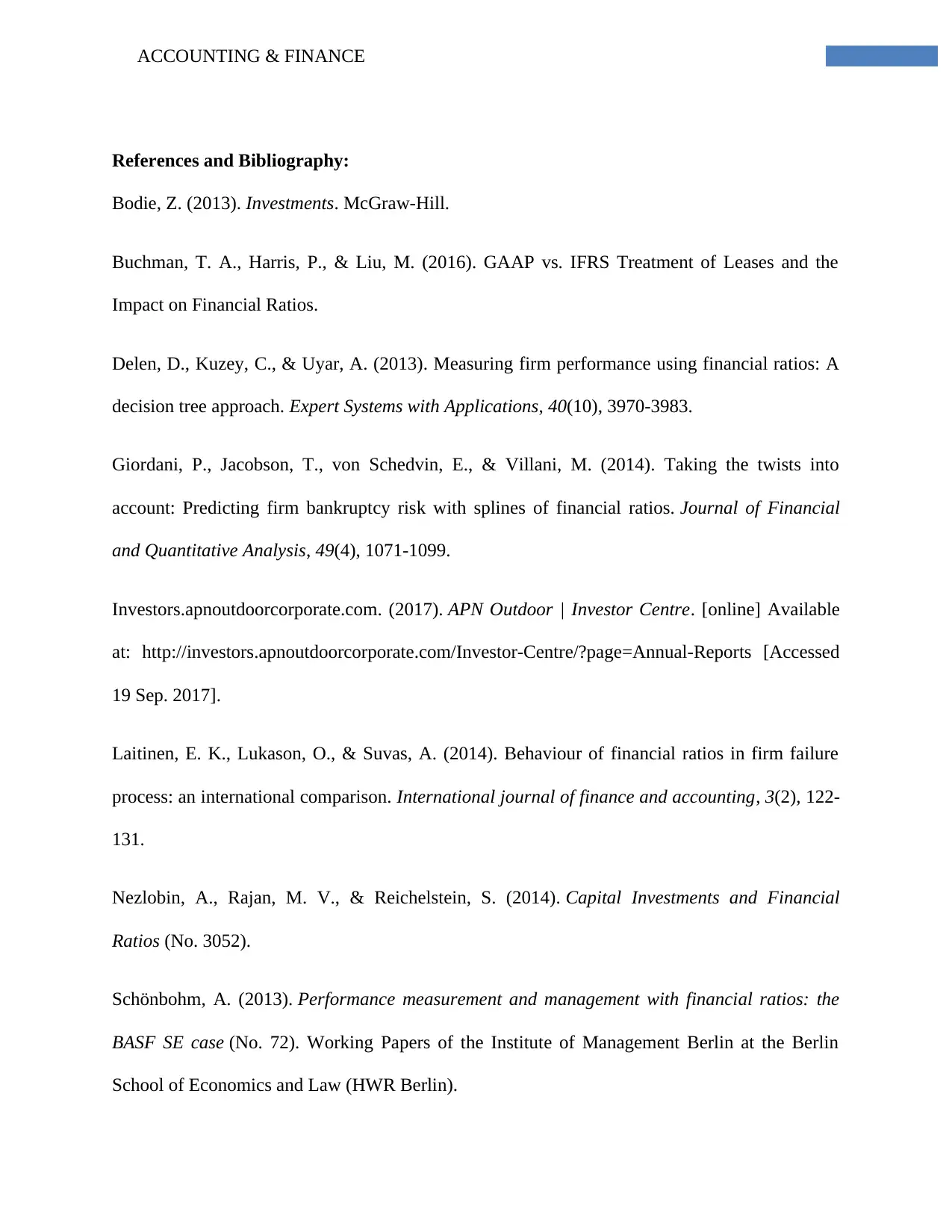
ACCOUNTING & FINANCE
References and Bibliography:
Bodie, Z. (2013). Investments. McGraw-Hill.
Buchman, T. A., Harris, P., & Liu, M. (2016). GAAP vs. IFRS Treatment of Leases and the
Impact on Financial Ratios.
Delen, D., Kuzey, C., & Uyar, A. (2013). Measuring firm performance using financial ratios: A
decision tree approach. Expert Systems with Applications, 40(10), 3970-3983.
Giordani, P., Jacobson, T., von Schedvin, E., & Villani, M. (2014). Taking the twists into
account: Predicting firm bankruptcy risk with splines of financial ratios. Journal of Financial
and Quantitative Analysis, 49(4), 1071-1099.
Investors.apnoutdoorcorporate.com. (2017). APN Outdoor | Investor Centre. [online] Available
at: http://investors.apnoutdoorcorporate.com/Investor-Centre/?page=Annual-Reports [Accessed
19 Sep. 2017].
Laitinen, E. K., Lukason, O., & Suvas, A. (2014). Behaviour of financial ratios in firm failure
process: an international comparison. International journal of finance and accounting, 3(2), 122-
131.
Nezlobin, A., Rajan, M. V., & Reichelstein, S. (2014). Capital Investments and Financial
Ratios (No. 3052).
Schönbohm, A. (2013). Performance measurement and management with financial ratios: the
BASF SE case (No. 72). Working Papers of the Institute of Management Berlin at the Berlin
School of Economics and Law (HWR Berlin).
References and Bibliography:
Bodie, Z. (2013). Investments. McGraw-Hill.
Buchman, T. A., Harris, P., & Liu, M. (2016). GAAP vs. IFRS Treatment of Leases and the
Impact on Financial Ratios.
Delen, D., Kuzey, C., & Uyar, A. (2013). Measuring firm performance using financial ratios: A
decision tree approach. Expert Systems with Applications, 40(10), 3970-3983.
Giordani, P., Jacobson, T., von Schedvin, E., & Villani, M. (2014). Taking the twists into
account: Predicting firm bankruptcy risk with splines of financial ratios. Journal of Financial
and Quantitative Analysis, 49(4), 1071-1099.
Investors.apnoutdoorcorporate.com. (2017). APN Outdoor | Investor Centre. [online] Available
at: http://investors.apnoutdoorcorporate.com/Investor-Centre/?page=Annual-Reports [Accessed
19 Sep. 2017].
Laitinen, E. K., Lukason, O., & Suvas, A. (2014). Behaviour of financial ratios in firm failure
process: an international comparison. International journal of finance and accounting, 3(2), 122-
131.
Nezlobin, A., Rajan, M. V., & Reichelstein, S. (2014). Capital Investments and Financial
Ratios (No. 3052).
Schönbohm, A. (2013). Performance measurement and management with financial ratios: the
BASF SE case (No. 72). Working Papers of the Institute of Management Berlin at the Berlin
School of Economics and Law (HWR Berlin).
⊘ This is a preview!⊘
Do you want full access?
Subscribe today to unlock all pages.

Trusted by 1+ million students worldwide
1 out of 12
Related Documents
Your All-in-One AI-Powered Toolkit for Academic Success.
+13062052269
info@desklib.com
Available 24*7 on WhatsApp / Email
![[object Object]](/_next/static/media/star-bottom.7253800d.svg)
Unlock your academic potential
Copyright © 2020–2025 A2Z Services. All Rights Reserved. Developed and managed by ZUCOL.





